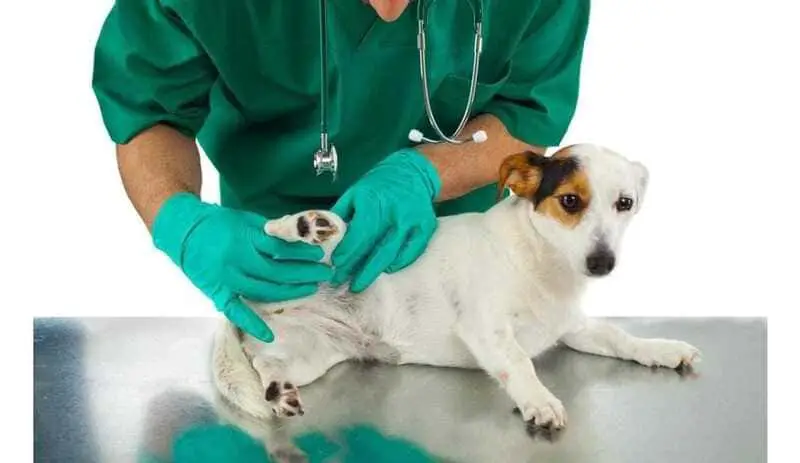Introduction to flea problems in pets.
Fleas on pets are a common and unpleasant problem that can affect dogs and cats of all ages and sizes. Fleas not only cause discomfort to animals, but they can also transmit diseases and cause allergies and skin problems. In addition, a flea infestation in the home can be difficult to control and requires constant effort to keep at bay.
Fleas are small, jumping insects that feed on the blood of animals. Although they can be difficult to detect, common signs of an infestation include excessive scratching, hair loss and the presence of fleas or eggs in the animal’s fur.

Effective flea control in pets requires a multi-faceted approach that includes prevention, treatment and maintaining a flea-free environment. This includes the use of preventative products, such as collars, spot-on or tablets, as well as treatment of the home and bedding to prevent re-infestation. In this article we will demonstrate various methods of how to control fleas on pets. From how to identify them to how to exterminate them.
It is important to take the problem of fleas on pets seriously and work with a veterinarian to develop an effective plan of action. With proper care and ongoing prevention, it is possible to keep pet’s flea-free and protect the family from the risks associated with these parasites.
How to identify the presence of fleas on pets.
In order to accomplish the task of how to control fleas on pets, we must first identify the presence of fleas, and this can be a challenge, but it is important to ensure quick and effective treatment. Here are some signs to look out for to detect a flea infestation:
1- Excessive scratching: If your pet starts scratching persistently, especially on the back and at the base of the tail, it may be a sign of a flea infestation.

2- Hair loss: Fleas can cause irritation to your pet’s skin, which can result in hair loss in affected areas.
3- Presence of fleas and eggs: Checking your pet’s coat for fleas and eggs can be a reliable way to detect an infestation. Fleas are small and dark and move quickly, while eggs are white and often found at the base of the pet’s fur.
4- Itchy skin: Flea infestation can cause your pet’s skin to itch, which can result in excessive scratching and skin lesions.
If you suspect your pet may have fleas, it is important to consult a veterinarian to receive an accurate diagnosis and proper treatment plan. With proper care and a preventative approach, it is possible to control and prevent the presence of fleas on your pet.
Importance of preventive flea treatment.
Flea preventative treatment is a critical aspect of the health and well-being of your pet and your home. By using flea preventative products, you can not only prevent infestation after successful treatment, but also protect your pet against flea-borne diseases.
Fleas can cause a great deal of discomfort and itching on your pet’s skin, which can result in excessive scratching and skin lesions. In addition, a flea infestation can be costly and time-consuming to treat, making prevention even more important.
It is critical to speak with a veterinarian to determine the best prevention plan for your pet. This plan may include the use of preventative products, such as collar, spot-on or pills, as well as maintaining a flea-free environment. This may include regular cleaning of areas where your pet spends time, elimination of any potential sources of infestation, and regular vaccination against flea-borne diseases.

Preventive flea treatment is a crucial aspect of keeping your pet healthy and protecting your home from these nasty parasites. By implementing a preventative approach, you can ensure that your pet and your home are free of flea infestations and enjoy a stress-free life.
Different methods of flea control for pets, including medications and topical products.
There are a variety of pet flea control methods available on the market. These include oral medications, topical products and environmental solutions. Each method has its own pros and cons, so it is important to speak with a veterinarian to determine the best treatment plan for your pet.
Oral medications are a popular choice for flea control in pets. These medications are often effective in preventing and treating flea infestations. However, it is important to note that some oral medications can have side effects and require regular dosing to be effective.
Topical products, such as lotions, sprays and pipettes, are a popular choice for flea control in pets. These products are applied directly to the pet’s skin and can be effective in preventing and treating flea infestations. However, it is important to follow dosing and application instructions carefully to avoid possible adverse reactions.
In addition to medications and topical products, there are also environmental solutions for flea control in pets. These include products for cleaning and disinfecting areas where your pet spends time, as well as products for eliminating any potential sources of infestation.
There are a variety of pet flea control methods available, each with its own pros and cons. It is important to speak with a veterinarian to determine the best treatment plan for your pet and to make sure you are using the right products and medications safely and effectively.
Tips to keep the home free of fleas and avoid infestations.
How to control fleas on pets is essential to avoid infestations on pets and people. Here are some tips to help prevent and control fleas in the home:
1- Maintain hygiene: Regular cleaning of your home is essential to prevent the buildup of fleas and other parasites. Regularly wash areas where your pet spends time, including beds, toys and resting areas. Also, regularly wash carpets and upholstery and use a HEPA-filter vacuum to pick up fleas and their eggs.
2- Treat all pets: If one pet in your home is infested with fleas, it is important to treat all pets in the home to avoid infestations. This includes any pets that do not have symptoms, but may have been in contact with fleas.
3- Use flea control products: There are a variety of products available to help prevent and control fleas in the home. These include products for cleaning and disinfecting areas where your pet spends time, as well as products for eliminating any potential sources of infestation.
4- Regularly check your pet: It is important to regularly check your pet to detect any flea infestation early. Look for fleas, eggs or dander on your pet’s skin and coat, especially on the legs, neck and base of the tail.
Keeping the home free of fleas is important to prevent infestations in pets and people. Regular cleaning, treatment of all pets, use of flea control products and regular checking of your pet are key to avoiding infestations.
Risks and precautions to consider when treating fleas on pets.
Treating fleas on pets is important to maintain the health and well-being of your pet and your home. However, it is important to keep in mind some risks and precautions when choosing and applying a flea product.
Choosing the right product: There are a variety of products available to treat fleas on pets, but not all are right for every pet. It is important to talk to your veterinarian to determine the best product for your pet, taking into account its age, size, weight and health status.

Follow application instructions: It is important to carefully follow application instructions when applying any flea product to your pet. Applying a product incorrectly may result in unwanted side effects or insufficient flea protection.
Consider side effects: Some flea products may have side effects on some pets. It is important to talk to your veterinarian about possible side effects and how to prevent or treat them.
Avoid exposure to humans and other animals: Some flea products may be harmful to humans or other animals. It is important to avoid skin contact or accidental ingestion of any product applied to your pet.
It is important to consider some risks and precautions when choosing and applying a flea product to your pet. Talking with your veterinarian to determine the best product, carefully following application instructions and considering possible side effects are key to safe and effective treatment.
Conclusion and recommendations for keeping pets free of fleas.
In conclusion, keeping pet’s flea-free is an important aspect of their well-being and health. A preventive flea treatment can help prevent infestations and ensure a healthy life for your pet. In addition, a flea-free home can protect other animals and people living in the home.
Here are some recommendations for how to control fleas on pets:
Talk to your veterinarian: It is important to talk to your veterinarian about the best flea preventative treatment for your pet.
Maintain a clean, flea-free home: Regular dirt removal and sunlight can help keep your home flea-free.
Keeping your pet clean: Regularly bathing your pet and keeping its coat short and clean can help prevent flea infestations.
Treat your pet and your home simultaneously: If your pet has fleas, it is important to treat both your pet and your home to prevent infestations.
In summary, talking to your veterinarian, maintaining a clean and flea-free home, keeping your pet clean, and treating your pet and home simultaneously are key to keeping your pet flea-free and ensuring its well-being and health.
